
The Rolls-Royce Merlin is a British liquid-cooled V-12 piston aero engine of 27-litres capacity. Rolls-Royce designed the engine and first ran it in 1933 as a private venture. Initially known as the PV-12, it was later called Merlin following the company convention of naming its piston aero engines after birds of prey.

The Bristol Pegasus is a British nine-cylinder, single-row, air-cooled radial aero engine. Designed by Roy Fedden of the Bristol Aeroplane Company, it was used to power both civil and military aircraft of the 1930s and 1940s. Developed from the earlier Mercury and Jupiter engines, later variants could produce 1,000 horsepower (750 kW) from its capacity of 1,750 cubic inches by use of a geared supercharger.

The Bristol Mercury is a nine-cylinder, air-cooled, single-row, piston radial engine. Designed by Roy Fedden of the Bristol Aeroplane Company it was used to power both civil and military aircraft of the 1930s and 1940s. Developed from the earlier Jupiter engine, later variants could produce 800 horsepower (600 kW) from its capacity of 1,500 cubic inches by use of a geared supercharger.

The Bristol Perseus was a British nine-cylinder, single-row, air-cooled radial aircraft engine produced by the Bristol Engine Company starting in 1932. It was the first production sleeve valve aero engine.

The Napier Sabre was a British H-24-cylinder, liquid-cooled, sleeve valve, piston aero engine, designed by Major Frank Halford and built by D. Napier & Son during World War II. The engine evolved to become one of the most powerful inline piston aircraft engines in the world, developing from 2,200 hp (1,600 kW) in its earlier versions to 3,500 hp (2,600 kW) in late-model prototypes.

The Aquila was a nine-cylinder single-row radial aircraft engine designed by the Bristol Engine Company starting in 1934. A sleeve valve engine, its basic design was developed from the Bristol Perseus. The Aquila was never used in production, but further developments led to the Bristol Hercules, Bristol Taurus, and Bristol Centaurus.

The Taurus was a British 14-cylinder two-row radial aircraft engine, produced by the Bristol Engine Company starting in 1936. The Taurus was developed by adding cylinders to the existing single-row Aquila design and transforming it into a twin-row radial engine, creating a powerplant that produced just over 1,000 horsepower (750 kW) with very low weight.
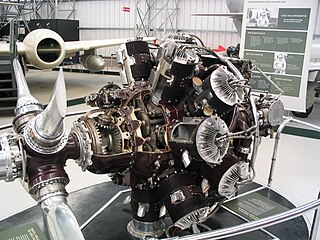
The Bristol Hercules was a 14-cylinder two-row radial aircraft engine designed by Sir Roy Fedden and produced by the Bristol Engine Company starting in 1939. It was the most numerous of their single sleeve valve designs, powering many aircraft in the mid-World War II timeframe.

The Mitsubishi Kasei was a two-row, 14-cylinder air-cooled radial engine built by Mitsubishi Heavy Industries and used in a variety of World War II Japanese aircraft, such as Mitsubishi J2M and Mitsubishi G4M. The Mitsubishi model designation for this engine was A10 while it was an experimental project, in service it was known as the MK4, and known as the Ha101 & Ha111 by the Army and Kasei by the Navy. According to unified designation code it was Ha-32 of the variants from 11 to 27.

The Hispano-Suiza 8 was a water-cooled V8 SOHC aero engine introduced by Hispano-Suiza in 1914, and was the most commonly used liquid-cooled engine in the aircraft of the Entente Powers during the First World War. The original Hispano-Suiza 8A was rated at 140 hp (100 kW) and the later, larger displacement Hispano-Suiza 8F reached 330 hp (250 kW).
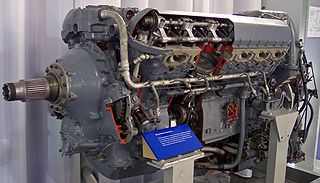
The Rolls-Royce Griffon is a British 37-litre capacity, 60-degree V-12, liquid-cooled aero engine designed and built by Rolls-Royce Limited. In keeping with company convention, the Griffon was named after a bird of prey, in this case the griffon vulture.

The Rolls-Royce Eagle Mk XXII was a British 24-cylinder, sleeve valve, H-block aero engine of 46 litre displacement. It was designed and built in the early-1940s by Rolls-Royce Limited and first ran in 1944. It was liquid-cooled, of flat H configuration with two crankshafts and was capable of 3,200 horsepower at 18 psi boost.
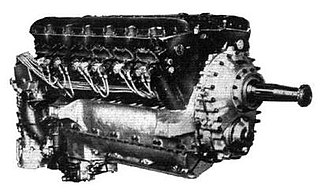
The Rolls-Royce Goshawk was a development of the Rolls-Royce Kestrel that used evaporative or steam cooling. In line with Rolls-Royce convention of naming piston engines after birds of prey, it was named after the goshawk.

The Armstrong Siddeley Cheetah is a seven-cylinder British air-cooled aircraft radial engine of 834 cu in capacity introduced in 1935 and produced until 1948. Early variants of the Cheetah were initially known as the Lynx Major.

The Armstrong Siddeley Jaguar was an aircraft engine developed by Armstrong Siddeley. The Jaguar was a petrol-fuelled air-cooled 14-cylinder two-row radial engine design. The Jaguar III was first used in 1923, followed in 1925 by the Jaguar IV and in 1927 by the Jaguar VI. In 1925 the Jaguar became the first production aero engine incorporating a geared supercharger.

The Armstrong Siddeley Tiger was a British 14-cylinder air-cooled aircraft radial engine developed by Armstrong Siddeley in the 1930s from their Jaguar engine. The engine was built in a number of different versions but performance and dimensions stayed relatively unchanged. The Tiger VIII was the first British aircraft engine to use a two-speed supercharger.

The RAF 4 was a British air-cooled, V12 engine developed for aircraft use during World War I. Based on the eight–cylinder RAF 1 it was designed by the Royal Aircraft Factory but produced by the two British companies of Daimler and Siddeley-Deasy. The RAF 5 was a pusher version of the same engine.
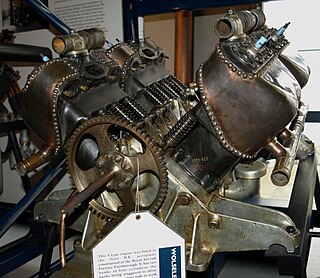
The Wolseley 60 hp or Type C was a British liquid-cooled V-8 aero engine that first ran in 1910, it was designed and built by Wolseley Motors. The engine featured water-cooled exhaust ports and employed a 20 lb (9 kg) flywheel. During an official four-hour test the engine produced an average of 55 horsepower. A larger capacity variant known as the 80 hp or Type B used an internal camshaft and propeller reduction gear.
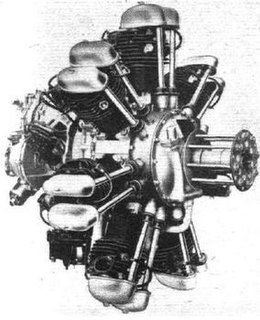
The Wolseley Aquarius I or A.R.7 was a British seven-cylinder, air-cooled radial aero engine that first ran in 1933, it was designed and built by Wolseley Motors. Intended for the military trainer aircraft market few were produced, as Wolseley withdrew from the aero engine market in 1936.

The Walter Bora was a Czechoslovakian nine-cylinder, air-cooled radial engine for powering light aircraft that was developed in the 1930s by Walter Aircraft Engines.


















